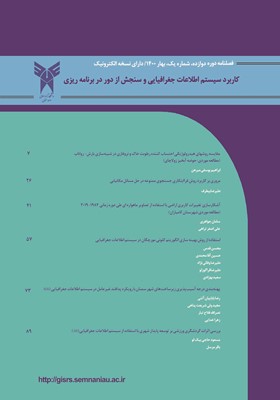آشکارسازی تغییرات کاربری اراضی با استفاده از تصاویر ماهواره ای طی دوره زمانی 2019-1984 (مطالعه موردی شهرستان کامیاران)
محورهای موضوعی : کاربرد GIS&RS در برنامه ریزیسامان جواهری 1 * , علی اصغر تراهی 2
1 - گروه آموزشی سنجش از دور و gis.دانشکده جغرافیا. دانشگاه خوارزمی تهران
2 - استاد دانشگاه و هیت علمی خوارزمی
کلید واژه: کاربری اراضی, آشکارسازی تغییرات, طبقه بندی نظارت شده, روش شبکه عصبی, تصاویر ماهواره ای ,
چکیده مقاله :
تغییرات کاربری اراضی در اثر فعالیت های انسانی یکی از موضوعات مهم در برنامه ریزی های منطقه ای و توسعه ای می باشد. با توجه به مزیت ها و قابلیت هایی که داده های ماهواره ای دارند، این تکنولوژی می تواند کمک شایانی به شناسایی و کشف این تغییرات نماید. هدف از این تحقیق آشکارسازیتغییراتکاربریاراضی شهرستان کامیارانبااستفادهاز تصاویر ماهواره ای طی دوره 35 ساله می باشد. دراینمطالعهازداده های سال 1984سنجنده TM ، 2000 سنجنده ETM+و 2019 سنجنده OLIماهواره لندست استفاده شد. در ابتدا پیش پردازش های اولیه شامل تصحیحات رادیومتری، اتمسفری و هندسی بروی داده خام انجام گرفت. از نقاطکنترلزمینی جهتآموزش،اعتبارسنجیوبرایتهیهنقشهکاربریاراضیاستفادهشد.کلاسکاربری درهرنقطهباپیمایشمیدانیوبااستفادهازتصاویرگوگلارث در 9 کلاس کاربری زمین هایکشاورزی،جنگل ،باغ،مراتعغنی و مشجر،مراتعمتوسط، مناطقمسکونی،پهنهآبی، زمین های بایر و رخنمون سنگیمشخصگردید.در ادامه از روش شبکه عصبی برای طبقه بندی نظارت شده تصاویر در نرم افزار ENVI 5.3استفاده شد. نتایج ارزیابی نشان داد که صحت کلی و ضریب کاپای تصاویر طبقه بندی شده OLI به ترتیب 94.3 و 0.92 درصد، ETM+92.6 و 0.91 درصد و TM90.3 و 0.87 درصد می باشد. نتایج مشخص کرد که اراضی جنگلی و مراتع غنی و مشجرکاهش محسوسی در طی سه بازه زمانی داشته که به ترتیب 11.64 و 19.12 درصد کاهش یافته است. به طوری که مراتع غنی و مشجر تا سال 2000 روندی افزایشی و در بازه زمانی بعدی تا سال 2019 روند کاهشی داشته است. اراضی مسکونی، پهنه آبی و باغات روند افزایشی داشته و به ترتیب 2.27، 0.57 و 3.98 درصد رشد افزایشی داشته است.
Land use change due to human activities is one of the important issues in regional and development planning. Given the advantages and capabilities of satellite data, this technology can be of great help in identifying and detecting these changes. The purpose of this study is to detect land use changes in Kamyaran city using satellite images over a period of 35 years. In this study, data from 1984 TM sensor, 2000 ETM + sensor and 2019 Landsat OLI sensor were used. Initially, preliminary preprocessions including radiometric, atmospheric and geometric corrections were performed on the raw data. Land control points were used for training, accreditation and to prepare land use map. Land use class was determined by field survey and using Google Earth images in 9 land use classes of agricultural lands, forests, gardens, rich and wooded pastures, medium rangelands, residential areas, water area, barren lands and rock outcrops. Next, the neural network method was used to monitor the images in ENVI 5.3 software. The evaluation results showed that the overall accuracy and kappa coefficient of OLI classified images are 94.3 and 0.92%, ETM + 92.6 and 0.91% and TM 90.3 and 0.87%, respectively. The results showed that forest lands and rich and wooded pastures decreased significantly during three time periods, which decreased by 11.64 and 19.12 percent, respectively. So that rich and wooded pastures have an increasing trend until 2000 and in the next period until 2019 has a decreasing trend. Residential lands, water areas and gardens increased by 2.27%, 0.57% and 3.98%, respectively. Due to the growing trend of population and urbanization, the results of this study provide the necessary information to make basic decisions in the development of management policies for planners and regional managers for the sustainability and evaluation of natural resources.
_||_

